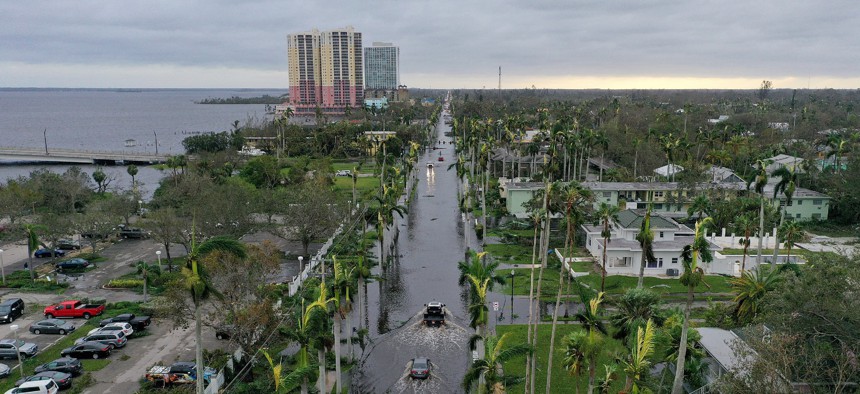Signs that 'faceless bureaucrats' helped mitigate the impact of Hurricane Ian

Vehicles make their way through flooded streets in the aftermath of Hurricane Ian in Fort Myers, Fla. Joe Raedle/Getty Images
A look at cities and towns in the path of Hurricane Ian that escaped devastation points to the value of modern building codes – and the officials behind their implementation.
The eye of one of the most-powerful hurricanes ever passed over coastal Florida cities such as Punta Gorda. Yet, the Washington Post reported, in the aftermath of Hurricane Ian, "a number of homes and buildings appeared largely intact and many showed only minimal damage to their exteriors."
How was this possible? "One major factor, according to some experts, is modern building codes."
Stricter building codes came to Florida after Hurricane Andrew in 1992. In 2004 Hurricane Charley devastated Punta Gorda, and led to a newer, even stricter code adopted in 2007. One source interviewed by the Post stated that "in the aftermath of Ian, the buildings left still standing seemed to have at least one thing in common. Everything with a 2007 code and beyond pretty much was fine."
"Buildings constructed using modern codes," the article continued, "have a slew of structural advantages that can help them better withstand extreme weather, including major storms. For instance, updated codes often have stricter requirements around "structural load continuity," which involves ensuring that a roof is well-connected to walls and the walls are well-connected to the structure's foundation."
There is one important thing missing from the Post article, however, and that's the people who developed these codes.
These people are government bureaucrats – those inclined to be negative will use the word "faceless" to describe them. They work in government agencies, and their job is to develop various government policies, rules and regulations. They work on these issues fulltime, developing knowledge, expertise, and solutions. They labor in obscurity while ordinary people are paying what they do not even the most-minimal attention. The rest of us learn they exist (if then) only when an emergency or crisis requires the services of what they do. But because they had done what they did in earlier years, Punta Gorda survived a monster hurricane much better.
Few blog readers will recognize the Joni Mitchell song Big Yellow Taxi by its title, but many will remember its iconic refrain – "You don't know what you've got till it's gone." The historic Florida hurricane suggests a new version of these words -- you don't know what you've got till it works. And the Florida hurricane story reminds us all of the good that "faceless" bureaucrats do for us.


